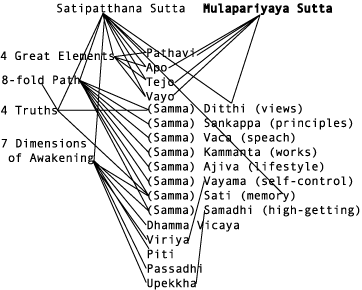[ Come Beggar! ]
Glossology
Sunday, September 07, 2003 12:06 PM
At this point I think its fair to say that the Glossology section has reached another order of completion. There are a lot of raggedy edges, but as a unit it is now close to 75% complete (that doesn't mean it will not grow to be 100% more complete, that means that there are very few pages where the basic information about a concept is not supplied with a few references at least). There remains a major aspect of the idea to finish: linking from the rest of the site. Still I would say anyone wishing to research a concept found in the Glossology at this point will find plenty of food for thought.
If you haven't visited the section recently, its now worth another look.
This is a project that is still (and probably always will be) under development: It evolved from an idea for an "Index to Dhammas" and what I had been calling "The Comparative Vocabulary Project" combined with an ordinary glossary. Shortly after starting it I revisited the Sangiti Sutta, and it was clear that there were advantages to be gained for the Glossology project to doing a new translation of this sutta and incorporating the terminology developed in that effort into the Glossology. Working on any given term quickly provides leads into other terms and it is an unusual day when more can be included than must be let go.
This is the structure at this time:
[ ] Tables of Comparative Vocabularies of the various translators organized by "Dhamma" (major category of practice or building-block of the system) with the individual Pāḷi terms therein are linked to
[ ] Individual pages discussing that term. Links from that page lead to:
[ ] the various "Dhammas" to which that term belongs,
[ ] discussions of that term on the main website,
[ ] Suttas in the Sutta Index that deal with that term, and to
[ ] whatever other helpful material can be found.
Approaching it from the other end, Pāḷi terms and major concepts that come up in the course of discussions, within suttas, and so forth will be linked to the term or Dhamma in the Glossology.
I have seen another way this could be done which would be very helpful: a kind of 3-D navigation bar where each concept clicked becomes a central focus, with its various links radiating out from it; then, in turn, those nodes at the ends of the spokes can be clicked, and so forth.
A rough idea with just a couple of concepts in two dimensions looks like this (imagine being able to click on the term, bringing it into focus with all related terms, then being able to click on a "node" to bring up a summary of and link to that page:

Without such a visual device, in the beginning it will seem like there is an out-of-control number of new concepts to learn in this system; putting it together in this way will show that in fact there are a few dozen terms being used over and over in different ways. This should be encouraging to those who look at the 25 plus volumes of translations of the Pāḷi and think to themselves that getting a grasp on the system is impossible. This will also argue strongly for the case that actually memorizing the whole thing is not nearly the daunting task that it seems.
Finally, I would like to say that it is completely amazing to me the suitability of this medium (computers, the internet, and html linking — even just 2-dimensional linking) for this study. It seems like the system was made with linking in mind!
This begins to look more and more like a useful tool. Some of the references are beginning to feed into each other, and the cross linking is now becoming very complex ... and this is only what I would call the basic infrastructure.
Saturday, December 12, 2009 9:11 AM
A different approach to presentation of the various Dhammas and their interrelationships is now to be found in The Method. Here the Dhamma is presented in outline with links to the various building blocks. Those building blocks are then also linked to the other building blocks. In all cases the definitions are from the suttas themselves.
